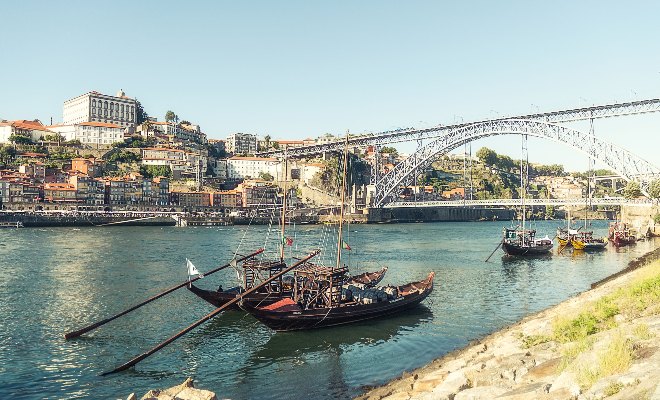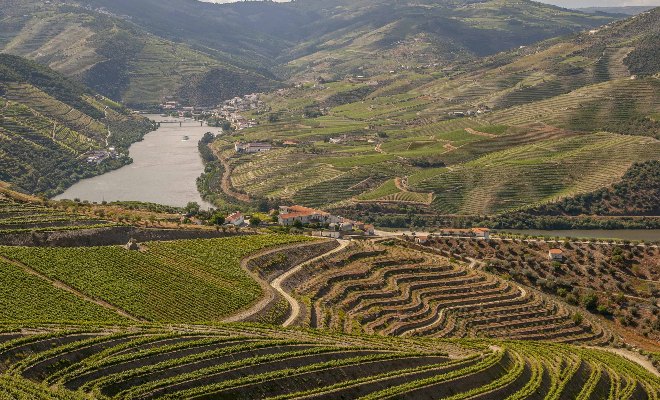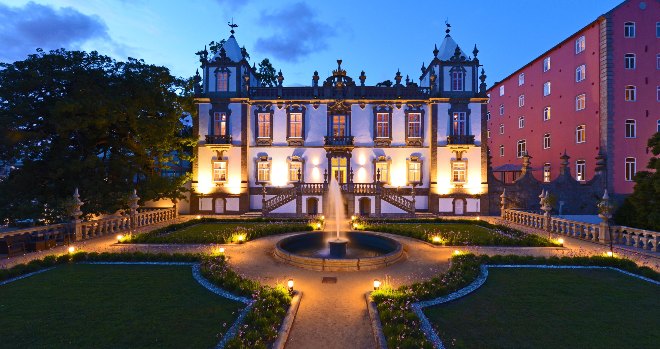Official UK partner to the Paradors, Pousadas, Pestana Hotels & Resorts, Les Collectionneurs (Chateaux), and European Hotels Collection. Keytours International, formerly Keytel International, your agent in the UK.
Porto, gateway to the Douro Valley
The only sounds are the birds, the leaves rustling and the whisper of the vine leaves. A varying, beautiful landscape – comparable to those of Tuscany and Napa Valley. You cannot help but be impressed by the mesmerising scenery of northern Portugal and particularly by the Douro valley.
If your idea of Portugal is ”all sardines and chourizo”, let us introduce you to a much more sophisticated aspect of this diverse country, one full of vibrant colour, traditional charm and authentic character.
The Douro river meanders through valleys of stepped grape vines and olive groves interspersed with grand manor houses, neat little villages and towns and the occasional title of a port house, depicted in large letters and standing out proudly from its setting. Immaculate terraces of vines join up like a patchwork quilt broken up by the white, mustard and terracotta shades of the houses, mansions and churches, and the zigzag of roads and paths that cross them. Long ranges of intensely dark and cheerfully green hills stretch into the distance with the occasional statue, cross or hamlet standing out in relief. Gorse bushes and rock roses regularly add colour to this canvas. It finally arrives at the Atlantic coast where it neatly parts the cities of Porto and Vila Nova de Gaia, set majestically on its banks.
One of the greatest attractions of Portugal is the easy driving once you are away from the bustling major cities of Porto, Lisbon and Faro, and the Douro region is one of the best to explore by car, armed with a camera.
With a population of 10.5 million, a landmass about a third of the size of Great Britain, and an excellent and modern road network, you cannot fail to enjoy a less pressurised experience behind the wheel as you pass through the remarkable landscapes of mainland Portugal.

Portugal’s gastronomic appeal has grown enormously and whilst you can still rely on the simple and delicious typical dishes that include freshly grilled sardines, meat and bean stews, and colourful salads, your taste buds will be delighted with the sophistication and elaboration of refined dishes such as carpaccio of octopus, trio of marinated fish and rhubarb and almond tartlets.
Recipes emerging from Portugal’s more experimental restaurants today blend local natural products from land, sea and river with French Spanish and Brazilian influence (amongst others), presenting you with a fresh, new gastronomic experience that cannot fail to impress.
Urban restaurants jossle with Quintas and Wine Estates for the top position on the food scene, with traditional and contemporary dishes on offer, whilst cafes and bars with their panoramic terrace settings challenge for the attention of discerning passers-by looking to enjoy a port tonic or a fine wine. Modern wineries vie with centuries-old wine estates for your attention, developing and proudly introducing a wide range of quality wines, often made from grapes that are native and unique to Portugal.
Value is another strength that Portugal can boast which, coupled with a minor revolution in hotel standards and design and a revitalised culinary offering, makes it an enormously attractive destination for those looking for high quality at a great price. Add to that some flashes of panache and some subtle reminders of its significant historical achievements and discoveries, you will find real Portugal is massively appealing. Portugal has discovered the perfect blend of contemporary and classic, combining authenticity with innovation and style. All at a very reasonable price.
The Douro region showcases all that is remarkable about Portugal, with Porto and ‘Gaia’ – the heartbeats of the region – leading you into a colourful landscape with lots to discover.
What is the appeal of the cities of Porto and Vila Nova de Gaia?
These cities straddle the picturesque Douro river, making up the Porto Metropolitan area. The waterfront and the historic quarter of ‘Gaia’ behind are where you will find the famous port wine warehouses and visitor centres, as well as fine terraces, restaurants and riverboat departures. Porto city covers a much greater area and you will find at its heart the museums, cathedral, markets and facades for which the city if so famous, as well as its own, longer waterfront that continues towards the Atlantic surfing beaches just around the corner. Both cities are connected easily and majestically by the Dom Luis I iron bridge with its huge arch, downriver from Gustav Eiffel’s Dom Maria Pia’s bridge.
Highlights of the twin cities include:
- the waterfronts with their lively terraces and restaurants. Enjoy the ‘petiscos’ (taster dishes)
- the cable car ride from the quayside to the heights of Gaia, to enjoy the superb views across and down the river
- Dom Luis I bridge, similarly a superb photostop
- twilight drinks on PortoCruz’s rooftop terrace, before their ”wine experience” and excellent restaurant.
- the 12th/13th century Romanesque cathedral and the walk down to the riverbank through the old streets
- Taylor’s wine cellar and port experience, one of the best in Gaia
- a Rabelo trip along the Douro and down to the mouth of the estuary
- a cycle ride along the riverbank west towards the surf beaches of Matusinhos, which is an enjoyable ride in very picturesque settings, rewardable with a great meal in one of the restaurants there
- a tram ride on one of the few original trams down towards the waterfront.
the Alfandega Transport Museum, both for its architecture and for its car collection - Our recommendation for a great hotel experience: the Pousada de Porto, a historic palace beside the river
Lorem ipsum dolor sit amet, consectetur adipiscing elit. Ut elit tellus, luctus nec ullamcorper mattis, pulvinar dapibus leo.

Where do we recommend from here?
An hour’s drive or an easy train ride east takes you into the more popular and visitable sections of the Douro valley, and between Peso da Regua and Vila Nova de Foz Coa you can enjoy visits to the famous wineries and their stepped vines, a steam train ride (during high season) from Regua to Pinhao’s idyllic station house with its charming tiled panels and boat trips along this particularly attractive section of the valley. You can spend several days here, particularly if you enjoy wine-tasting (both port and table wines) and walking.
Braga and Guimaraes are also well worth a visit, both cities within an hours’ drive from Porto. Guimaraes is the ‘’birthplace’’ of Portugal, chosen by their first king – King Afonso Henrique – as the administrative capital of Portugal following his victories over the Moors. This city is well worth an extended visit to see its substantial historic centre, castle ruins and the Palace of the Dukes of Braganza, as well as its lovely cobbled streets and squares. Guimaraes is renowned for its terraces and café lifestyle. A guided city is well recommended, since this is a fascinating historic city with so much to see and great charm to appreciate. There is a lovely historic Pousada here: Pousada de Guimaraes
Braga is also a lovely city to see, with a smaller historic centre and more shopping streets, and high above the city are the sanctuaries on the hills, the most significant of which being that of Bom Jesus do Monte with its shrine and church. This was the most important Roman settlement in northern Portugal and well worth a visit today.
Heading north towards the Minho river – Portugal’s natural frontier with Spain – through the Minho region, famous for its Vinho Verde and green lanscapes, takes you to Viana do Castelo, a historic port by the Lima estuary (see Pousada de Viana), and inland to Ponte de Lima with its mediaeval bridge and panoramic restaurant terraces. From there you can head into the Geres Canicada National Park, with its wealth of outdoor activities and highly rated walking routes through the valleys and across the hills, near the Spanish border.
Heading south takes you to Aveiro, with its canals, seafood restaurant and saltmarshes, and inland to Viseu with its baroque architecture and the Dao wineries nearby.
Where to stay?

We can thoroughly recommend – personally – most of the Pousadas in this region:
The Pousada at Geres-Canicada is set in the National Park with some of the finest views from its terrace, and similarly Viana do Castelo’s Pousada has tremendous views of the estuary and beaches below from its lofty position on the hilltop. The Pousada in Amares is a lovely historic Pousada, full of character, also within a short distance of the National Park. The Pousada in Guimaraes is one of our favourites, set in the 12th century convent slightly above the city.

In Porto, one of the best places to stay is the Pousada do Porto – the Baroque Palacio do Freixo – because of its tranquil setting just outside the centre and its fountains and terraces overlooking the Douro. In the centre of Porto and literally on the main waterfront esplanade, stands the Pestana Vintage Porto Hotel, housed in a collection of townhouses. This is another highly recommended hotel, whose appeal is its charm and location – it is the perfect choice for those looking to have all the sights on their doorstep.
Around the Douro valley, the Pousadas at Alijo and Marao are comfortable bases from which to explore with decent restaurants to enjoy in the evening.
The Pousada de Murtosa/Torreira/Aveiro is set by the waterfront, and the Pousada de Viseu is very central in this charming historic city.
